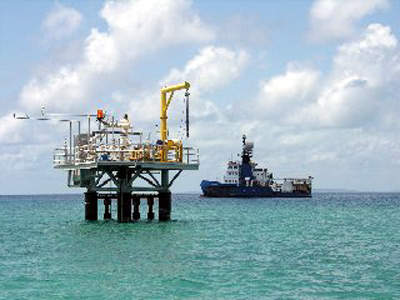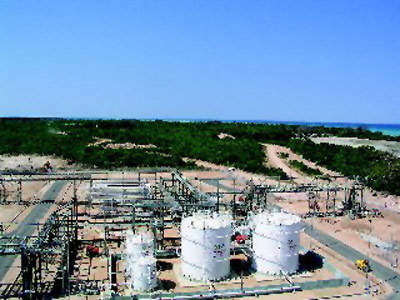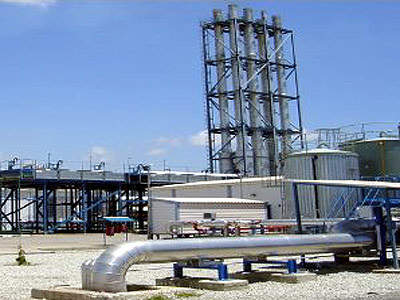The Songo Songo gas field is located on and offshore Songo Songo island, about 15km from the Tanzanian mainland and 200km south of the commercial capital, Dar es Salaam. The project serves two onshore and three offshore natural gas wells at the island, the gas from the wells being piped to a plant on the island.
The discovery well, Songo Songo-1, was drilled in l974 by AGIP, now a subsidiary of Italian oil and gas multinational Eni SpA.
The main sponsor of the $320m project was AES Sirocco of the US; the other sponsor was PanAfrican Energy, formerly Ocelot International. Investment in the project came from AES, PanAfrican Energy, Tanzania Electric Supply Company Ltd (Tanesco), Tanzania Petroleum Development Corporation (TPDC), UK investor CDC Group plc, Tanzania Development Finance Co Ltd (TDFL), the European Investment Bank and the World Bank, these last two through the Tanzanian Government.
The gas processing plant and pipelines were built and are owned by Songas Ltd, a local joint venture company formed by power company CDC Globeleq (itself formed by CDC Group), Tanesco, TPDC and TDFL. CDC Globeleq has the controlling interest in the project, and the gas plant and wells are operated on its behalf by PanAfrican Energy Tanzania Ltd, a local subsidiary of Orca Exploration Group Inc.
Construction of the pipeline network was completed in May 2004. The first gas reached Dar es Salaam in July 2004, and the project started commercial operation in July 2004. The network transports natural gas to Dar es Salaam where it is used as the principal fuel for turbine generators at Songas Ubungo power plant in Dar es Salaam to generate about 190MW of electricity – or 45% of the country’s capacity – for the national grid; a proportion of the gas also supplies a local cement plant, Wazo Hill, as well as a number of other industries and power plants in Dar es Salaam.
Geology
Songo Songo is a large north-south trending structure. The gas is contained in Lower Cretaceous inner shelf sand reservoirs with porosities averaging greater than 20%, and net porous intervals up to 155m thick.
The structure was uplifted during the Early Cretaceous and the reservoir modified by the Mid Cretaceous regional unconformity. The trap consists of two faulted highs separated by a saddle. A series of north-south and north-west-south-east trending faults step down to the east.
This faulting, regional eastward tilting, and rapid Tertiary sedimentation created more growth faults which mostly sole out in the sealing shales of the Upper Cretaceous Ruaruke Formation.
The Lower Cretaceous reservoirs are not affected by this later episode of faulting. Continued activity along these faults resulted in the development of broad, low-relief anticlines.
The gas is thought to have been sourced from post-mature organic material of Jurassic or Early Cretaceous age. The associated liquids are said to be probably sourced from mature organic matter of Early Cretaceous and Middle Cretaceous age that appear to have migrated from a nearby basin.
At the end of 2007, total proved and probable reserves were put at 474bn cu ft, with a Proven, Probable and Possible figure of 783bn cu ft.
Processing
Gas from the wells is processed by two 35Mmscf/d processing units (dehydration and refrigeration) on the island. Removed hydrocarbon liquids are shipped to Dar es Salaam.
After processing, the gas is transported along a 25km, 12in pipeline from Songo Songo to the mainland at Somanga Funga, and from there along a 207km, 16in pipeline to Ubungo and Wazo Hill.
Production
Daily production has risen from a 2004 average of about 12.6Mmscf/d to just over 51.2Mmscf/d for 2007. It reached the gas plant’s maximum nameplate capacity at the end of 2007, and by July 2008 it was in the range of 65-70Mmscf/d.
Under a production sharing agreement with TPDC, Orca, via PanAfrican Energy Tanzania Ltd, sells gas that’s surplus to that committed to Ubungo and Wazo Hill. It started selling this gas to new industrial customers in the Dar es Salaam area in September 2004, and by the end of 2007 it had 17 such customers connected via a low-pressure distribution network.
Demand in Tanzania for electrical power is soaring – in the 18 months to the end of 2007, 310MW of new gas-fired generation had been installed in the Dar es Salaam area, operating on gas from Songo Songo, and the country’s demand for electricity demand is forecast to grow by about 50MW a year for the foreseeable future, absorbing all recoverable gas production from the development that is not sold to industrial markets.
To meet this growth, during 2007 Orca drilled the first well at the project in 25 years, Songo Songo-10, and completed remedial work on the SS-9 well, adding an estimated 80Mmscf to the field’s deliverability.
Also, the current gas processing plant configuration limits supply to 70Mmscf/d, so the two trains on the island are being upgraded, and it is expected that this will raise capacity to 90Mmscf/d by the end of August 2008.
And during the third quarter of 2007, Orca also submitted a proposal to Songas to enable the island’s gas processing capacity to be increased by a further 15Mmscf/d by using a bypass system. Implementation of this work is expected to start in the second half of 2008.






